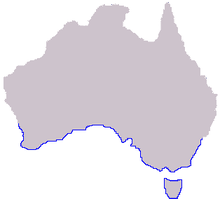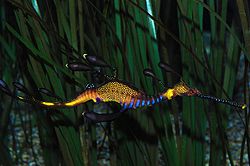- Phyllopteryx
-
Weedy seadragon 
Phyllopteryx taeniolatus in Cabbage Tree Bay, Sydney, Australia Conservation status Scientific classification Kingdom: Animalia Phylum: Chordata Class: Actinopterygii Order: Syngnathiformes Family: Syngnathidae Subfamily: Syngnathinae Genus: Phyllopteryx
Swainson, 1839Species: P. taeniolatus Binomial name Phyllopteryx taeniolatus
( Lacepède, 1804)Phyllopteryx taeniolatus range. Phyllopteryx taeniolatus, the weedy seadragon or common seadragon, is a marine fish related to the seahorse. It is the only member of the genus Phyllopteryx. Adult weedy seadragons are a reddish colour, with yellow and purple markings; they have small leaf-like appendages that provide camouflage and a number of short spines for protection.[1] Males have narrower bodies and are darker than females.[1] Seadragons have a long dorsal fin along the back and small pectoral fins on either side of the neck, which provide balance.[2] Weedy seadragons can reach 45 cm in length.
The weedy seadragon is the marine emblem of the Australian State of Victoria.[3]
Contents
Range
It is found around the southern coastline of Australia, approximately between Port Stephens, New South Wales and Geraldton, Western Australia, as well as around Tasmania.
Habitat
The weedy seadragon inhabits coastal waters down to at least 50 metres deep. It is associated with rocky reefs, seaweed beds, seagrass meadows and structures colonised by seaweed.[4]
Biology
These fish are slow-moving and rely on their camouflage as protection against predation; they drift in the water and with the leaf-like appendages resemble the swaying seaweed of their habitat.[1] They lack a prehensile tail that enables similar species to clasp and anchor themselves.
Individuals are observed either on their own or in pairs; feeding on tiny crustaceans and other zooplankton by sucking prey into their toothless mouths.[1] Like seahorses, seadragon males are the sex that cares for the developing eggs. Females lay around 120 eggs onto the brood patch located on the underside of the males tail.[1] The eggs are fertilised and carried by the male for around a month before the hatchlings emerge.[1] Seadragons, seahorses and pipefish are the only known species where the male carries the eggs. The young are independent at birth, beginning to eat shortly after.[5]
Mating in captivity is rare since researchers have yet to understand what biological or environmental factors trigger them to reproduce. In captivity the survival rate for weedy seadragons is about 60%.[6]
The Aquarium of the Pacific in Long Beach, California and the Tennessee Aquarium in Chattanooga, Tennessee[7] in the USA; and the Melbourne Aquarium in Melbourne, Australia[8] are the only facilities in the world to have successfully bred weedy seadragons in captivity, though others occasionally report egg laying.[9] As of June 2008, the Georgia Aquarium in Atlanta, USA had a pregnant seadragon, which was expected to give birth in early-mid July.[10]
Threats
The weedy sea dragon is classified as Near Threatened (NT) on the IUCN Red List 2006.[11] This species is not at present a target of the trade in Traditional Chinese Medicine, which is currently affecting seahorse numbers. However, they are likely to be threatened by the destruction of habitat that is occurring along coastal waters as a result of development and pollution.
Conservation
Currently, it is illegal to take or export these species in most of the states within which they occur.[1] A database of seadragon sightings, known as 'Dragon Search' has been established with support from the Marine and Coastal Community Network (MCCN), Threatened Species Network (TSN) and the Australian Marine Conservation Society (AMCS), which encourages divers to report sightings.[1] Monitoring of populations may provide indications of local water quality and seadragons could also become an important 'flagship' species for the often-overlooked richness of the unique flora and fauna of Australia’s south coast.[1]
Related species
A more cryptic relative of the weedy seadragon is the leafy seadragon, Phycodurus eques. In the November 2006 issue of National Geographic magazine, marine biologist Greg Rouse is reported as investigating the DNA variation of the two seadragon species across their ranges.
References
This article incorporates text from the ARKive fact-file "Phyllopteryx" under the Creative Commons Attribution-ShareAlike 3.0 Unported License and the GFDL.
- ^ a b c d e f g h i "Dragon Search". Dragon Search. http://www.dragonsearch.asn.au. Retrieved April, 2003.
- ^ "Melbourne Aquarium". Melbourne Aquarium. http://www.melbourneaquarium.com.au/viewanimal.asp?animalid=27&category=&page=2. Retrieved April, 2003.
- ^ Dept of Sustainability and Environment Victoria > The marine faunal emblem for the State of Victoria Retrieved 8 August 2011
- ^ "Western Australia Department of Fisheries". Western Australia Department of Fisheries. http://www.fish.wa.gov.au/rec/broc/fishcard/dragon.html. Retrieved April, 2003.
- ^ Morrison, Sue; Storrie, Ann (1999). Wonders of Western Waters: The Marine Life of South-Western Australia. CALM. pp. 68. ISBN 0 7309 6894 4.
- ^ Newsvine/Associated Press 12 June 2008
- ^ Tennessee Aquarium Website
- ^ Melbourne Aquarium > Weedy Seadragon Babies Retrieved 17 August 2011.
- ^ "Weedy Seadragons spawn for Hong Kong aquarist". AquaDaily. 2008-07-18. http://aquadaily.com/2008/07/18/weedy-seadragons-spawn-for-hong-kong-aquarist/. Retrieved 2009-02-01.
- ^ "Endangered sea dragon at Ga. aquarium pregnant". http://news.yahoo.com/s/ap/20080613/ap_on_fe_st/odd_pregnant_sea_dragon_4.
- ^ "IUCN Red List". IUCN Red List. http://www.iucnredlist.org/. Retrieved May, 2006.
External links
 Media related to Weedy sea dragon at Wikimedia Commons
Media related to Weedy sea dragon at Wikimedia Commons- Phyllopteryx media at ARKive
- Australian Museum Online - Leafy and Weedy Seadragons
- Leafy Seadragons and Weedy Seadragons
- Weedy Sea Dragon Monitoring Program in Botany Bay
- Leafy Sea Dragon Festival
- Weedy Sea Dragon
- Youtube Male Weedy Seadragon with eggs
- Youtube Weedy Seadragon
- Male Weedy Sea Dragon carrying eggs
- BBC Weedy seadragon videos, news and facts
Categories:- IUCN Red List near threatened species
- Syngnathidae
- Fish of Australia
Wikimedia Foundation. 2010.




